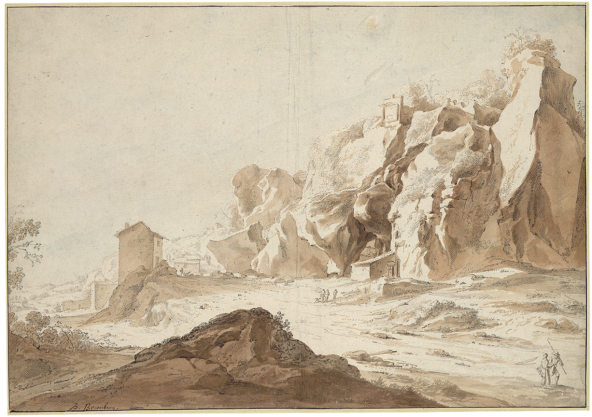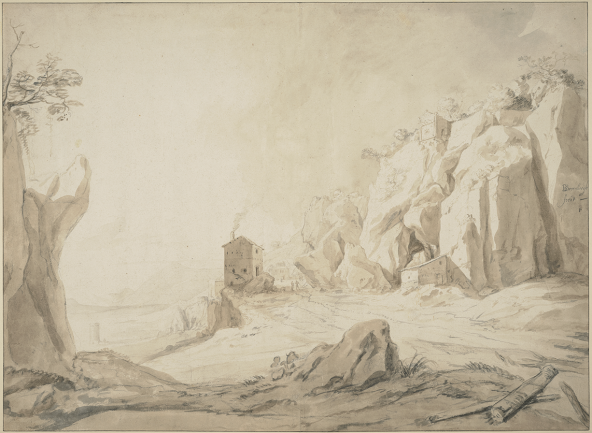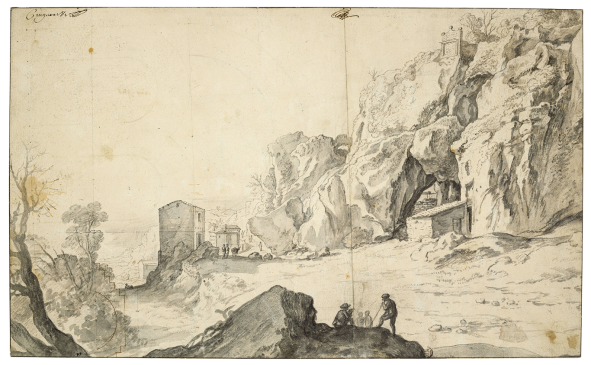Choose a background colour
Bartholomeus Breenbergh, Dutch, 1598-1657: Cliffs, Possibly near Bracciano, c. 1625
Pen and brown ink with brown and gray washes on paper; traces of framing lines in brown ink.
9 15⁄16 × 12 3⁄4 in. (25.2 × 32.4 cm)
backing sheet, at top center, in pencil, HP with a paraph; and lower right, No 33.
- Chain Lines:
- Vertical, 30 – 32 mm.
- Watermark:
- Crown with five points below a six-pointed star, cf. Heawood 1116.
- Provenance:
Sale, Christie’s, Amsterdam, 26 November 1984, lot 66; Ian Woodner, 1903– 1990, New York; his sale, Christie’s, London, 2 July 1991, lot 209; Sheldon and Leena Peck, Boston (Lugt 3847); gift to the Ackland Art Museum, inv. no. 2017.1.15.
- Literature/Exhibitions:
Roethlisberger 1985, 65; Roethlisberger 1991, 91; F. Robinson in Chapel Hill, Ithaca & Worcester 1999 – 2001, 38 – 39, no. 2; P. Schatborn in Amsterdam 2001, 66, 205 (note 8).
- Ackland Catalogue:
- 2017.1.15
This striking image depicts cliffs on a road near Bracciano, a town northwest of Rome famous for its volcanic lake. A small chapel or shrine appears at the top of the cliffs, a common feature along such roads. This one may have been reached by a path leading up the deep channel to the right of the structure.
Bartholomeus Breenbergh was among the first landscape specialists from the Dutch Republic to travel to Italy, remaining there from 1619 to 1629. Together with his contemporary Cornelis van Poelenburch, he pioneered a drawing technique using broad, sometimes sharply defined areas of wash next to the blank white area of the paper to create dramatic effects of sunlight. His innovative technique influenced younger artists like Jan de Bisschop and Constantijn Huygens II.
Along with his slightly older compatriot, Cornelis van Poelenburch (1594/95 – 1667), Bartholomeus Breenbergh was one of the first landscape specialists from the United Provinces that we know for certain traveled to Italy. He is recorded in Rome several times beginning in 1619 and appears to have returned to the Netherlands around 1629 where he settled in Amsterdam.1
Once back, he continued his career as a painter (and later as a merchant), often employing his experiences in Italy as subjects for his subsequent paintings and drawings. Breenbergh and Van Poelenburch, whose drawings are sometimes difficult to distinguish from each other, pioneered a remarkable new style of draftsmanship. They sought to express the strong effects of sunlight using broad and sometimes sharply applied areas of wash, subsuming the line work, and vividly defining radiant surfaces using the white reserve of the paper.2
This style would have a deep impact on artists in their ambit, most notably on the French artist Claude Lorrain (1604/05 – 1682), but also on subsequent generations of Dutch artists such as Jan de Bisschop (1628 – 1671) and Constantijn Huygens II (1628 – 1697).3
More than 200 of Breenbergh’s drawings survive, most of which depict Italian subjects.4
The present work bears an Italian watermark and must date to his Roman period, most likely in the mid-1620s when Breenbergh first experimented with his dramatic new style, shown to great effect here. The large size of this sheet nevertheless belies the fact that it was significantly cropped at some point. Franklin Robinson pointed out that the Peck drawing relates closely to at least three other sheets, two by Breenbergh himself, in the collections of the Albertina Museum and the J. Paul Getty Museum, and one by Paul Bril (1553/54 – 1626) in the Louvre Fig. 8.1 Fig. 8.2 Fig. 8.3.5

Bartholomeus Breenbergh, Italian Mountain Landscape. Black chalk, brush in brown, gray-brown, and rose washes, and blue wash in the sky, 379 × 543 mm. Vienna, Albertina, inv. no. 9369.
Albertina, Vienna

Bartholomeus Breenbergh, Landscape with a Road below Cliffs near Bracciano. Black chalk with black and gray wash, 409 × 562 mm. Los Angeles, J. Paul Getty Museum, inv. no. 2020.34.
The J. Paul Getty Museum, Los Angeles

Paul Bril, Mountain near Bracciano. Black chalk with brush in brown and gray wash, 283 × 468 mm. Paris, Musée du Louvre, inv. no. 19.771.
© RMN-Grand Palais/Art Resource, NY
These drawings reveal what was once the full extent of the Peck composition, with a road running along the base of the cliffs leading into the mountainous distance. The now off-center centerfold in the present sheet also makes clear that it once closely matched the actual size of these three other sheets, though several compositional differences in the foregrounds and backgrounds are easy to spot, and they vary significantly in style.
The obvious question arises as to which drawing came first. When compared to the two other sheets by Breenbergh, there are good reasons to assume that the present work was the prototype, especially since its more immediate and direct impression indicates a drawing made on-site. The drawing in the Albertina has a slightly stiffer appearance and employs a broader range of tones and ink types typical of a studio version. For the Peck sheet, Breenbergh mostly used a single type of brown ink, with the few additions in gray ink (notably on the large rock face at right) perhaps added later. The Getty’s version, which bears an authentic signature, is highly finished but different in style altogether. Its softly modulated lighting unifies the composition and reduces the craggy nature of the rock face, which in the Albertina and Peck drawings is shaper-edged and more obviously the heatbearing protagonist.
Breenbergh’s other large-scale Italian subjects also survive in two or three drawn versions, suggesting that the artist returned to the same subject repeatedly, unafraid to modify the style or further work up the composition.6
As Stijn Alsteens pointed out by studying the watermarks of two nearly identical versions of Breenbergh’s View of Tivoli, he may have made some of these replicas years apart, even decades after he had returned to Amsterdam.7
Since the watermark on the present sheet makes its Italian origin clear, the same disparate time span might be the case here, if he made the versions in the Albertina and Getty after his return.8
It is possible that Breenbergh made a regular practice of repeating his Italian subjects back home for a ready collectors’ market there.9
The drawing by Paul Bril in the Louvre complicates the story further Fig. 8.3.
Bril successfully spent his career in Rome, becoming the doyen of Dutch and Flemish painters there, several of whom he employed in his workshop, including Breenbergh. We know this from Breenbergh’s own testimony, given during a 1653 paintings appraisal, “that he spent around seven years working for Bril” (thus from Breenbergh’s arrival in Rome in 1619 until Bril’s death in 1626), and further that “he himself had copied various things of his in Rome.“10
While Breenbergh was referring to the copying of paintings in this statement, it certainly points to the possibility that the present drawing is a copy of Bril’s Louvre drawing. If so, it would be one of two examples that have come to light.11
The wash-intensive nature of the present sheet, however, advances the conception beyond anything that Bril had previously attempted. One wonders (as Peter Schatborn did) whether in a reversal of roles the young Breenbergh may have proven an influence on the aged Bril in this case.12
The latter’s sheet in the Louvre demonstrates a certain loosening of his style, but his notion of the cliffs remains reserved, treating the rocks as a large organic mass rather than the stony receptors of intense sunlight found in the Peck drawing.
Another possibility, as already suggested by Louisa Wood Ruby, is that this pair of drawings resulted from a sketching trip that Bril and Breenbergh took together.13
Sketching from the same spot was not an uncommon practice among landscape artists in the era, and Alan Chong has further pointed out that some of Van Poelenburch’s compositionally similar drawings are likewise indicative of joint sketching excursions with Breenbergh.14
In either case, the artist’s practice of making finished autograph replicas of his own drawings seems to have been inspired by Bril, who was one of the first landscape draftsmen to do so on a regular basis.15
This drawing was previously published as depicting a location near Bomarzo, but the Getty’s version bears an inscription in an early hand on the verso, Strada di Bracciano (Road of Bracciano), which is adopted here in the title.16
Both Bomarzo and Bracciano are plausible locations given Breenbergh’s relationship with Paolo Giordano II Orsini (1591 – 1656), a major patron of the arts who inherited the dukedom of Bracciano in 1615.17
His sizable duchy just north of Rome also included Bomarzo, with its famous Garden of Bomarzo (the “Park of Monsters”) full of odd, grotesque, and humorous sixteenth-century sculpture. Many of Breenbergh’s most significant Italian drawings were clearly made while traveling in Orsini’s duchy. Some depict sculptures in the Garden of Bomarzo, while others are more clearly set in and around Bracciano and its major lake, which lies about sixty kilometers to the south.18
One of his drawings actually depicts the duke and his entourage bathing in the lake, suggesting that Breenbergh accompanied Orsini while he traveled around his lands.19
Breenbergh’s drawing of the Torre di Chia (near Bomarzo) in the École des Beaux-Arts bears a nearly identical watermark as the present sheet, and it was also the subject of one or more replica drawings by the artist.20
While it might reasonably be assumed that the present work was made on Orsini lands, the exact location remains unknown, even if set on a road near Bracciano. Robinson suggested that the structure on top of the cliff is a portico to an estate (with a large shade with a sunburst design), but it seems more likely a small chapel or shrine of some sort that one would typically find dotting such roads.21
The deep channel in the rocks leading up to the right side of the structure might contain a path or steps to make it accessible from the road below.
End Notes
For an overview of Breenbergh’s life and related documents, see Nalis 1972; more summarily in Roethlisberger 1981, 1 – 5; and Amsterdam 2001, 66.
The most extensive treatment of Breenbergh’s drawings to date remains Roethlisberger 1969; see also P. Schatborn in Amsterdam 2001, 66 – 73; and the remarks in Alsteens 2015. For Van Poelenburch’s drawings, see Chong 1987, which also attempts to disentangle a few of his drawings from Breenbergh’s oeuvre.
Roethlisberger 1981, 19 – 20.
Roethlisberger 1969, 1, estimating about 200 drawings (three-quarters of which are treated in this monograph, not intended as complete); reiterated in Roethlisberger 1981, 5, but the number might now be slightly higher.
For the Albertina and Getty drawings, see Roethlisberger 1969, nos. 35, 35 (the latter then in a private collection). For the Bril, idem. no. 33; and Ruby 1999, no. 100. The relationship between the Peck drawing and these sheets was discussed earlier by F. Robinson in Chapel Hill, Ithaca & Worcester 1999 – 2001, no. 2. Robinson also pointed to a portion of the left-hand side of the composition repeated in a drawing given to Breenbergh, present whereabouts unknown, found in a dealer catalogue (Houthakker 1969, no. 6); the attribution of the latter seems questionable but can only be judged from the reproduction.
See Roethlisberger 1969, 9, nos. 13 – 14, 99 – 100; Alsteens 2015; and Chicago 2019 – 20, no. 90 (reproducing the left half of Roethlisberger 1969, no. 104).
The historical mounting of the Albertina sheet frustrates the study of any watermark that might be present; my thanks to Eva Michel for checking this in person.
As remarked in Alsteens 2015, 448, who notes that the dating of other drawings set in Italy should probably be reconsidered as well. Roethlisberger had assumed that the majority of Breenbergh’s surviving drawings were made in Italy since they depicted Italian subjects, but this might not actually be the case; see Roethlisberger 1969, 2.
Bredius 1889, 43.
See Depauw 1989; Depauw 1992; Depauw 1997; and Ruby 1999, no. 101.
Amsterdam 2001, 66.
Ruby 1999, 153, note 671 (in reference to cat. 100).
Chong 1987, 10.
For Bril’s autograph replicas, see Ruby 1999, 28 – 29 (“copy versions”); and for the practice generally, see Ruby 2013.
The confusion appears to have originated with Roethlisberger, who first noted the drawing without venturing a title (Roethlisberger 1985, 65) shortly after it appeared on the market, then supplied a brief description (Roethlisberger 1991, 93, under “Some newly appeared drawings”) with the title A Cliff (near Bomarzo?). This may have been a slip of the pen, since he knew about the inscription on the verso of the Getty sheet and had catalogued both related drawings as Landschaft (bei Bracciano?); see Roethlisberger 1969, nos. 34, 35.
Roethlisberger 1969Breenbergh’s seemingly vital relationship with Orsini is a topic that has only lightly been treated in the literature to date, but see Roethlisberger 1969, 8; and Schatborn in Amsterdam 2001, 67. See also the important recent study, Amendola 2014, which publishes for the first time a list of drawings found in the Orsini archives, including nine by Breenbergh (idem, 149 – 50, under folium 5 recto). The present drawing, being the only one of this subject on Italian paper, might possibly be the Casa sopra una montagniola listed therein, although this description applies just as well (if not better) to a drawing in Berlin (Roethlisberger 1969, no. 20; and Bock & Rosenberg 1930, no. 5436).
See Roethlisberger 1969, 8, for an account of these works. For Breenbergh in the Gardens of Bomarzo, see also Koolbergen 1984, 52 – 65.
Amsterdam 2001Amsterdam, Rijksmuseum, inv. no. rpt-1967 – 73; Amsterdam 2001, 67 (fi g. D); and Roethlisberger 1969, no. 107.
Inv. no. Mas. 1576; Roethlisberger 1969, no. 14 (and no. 13 for related drawing in St. Petersburg); see also Paris & Ajaccio 2014 – 15, no. 16. A third version on the art market was posited, perhaps incorrectly, as the prototype; see R. Verdi in Birmingham & The Hague 2004 – 05, no. 12.
